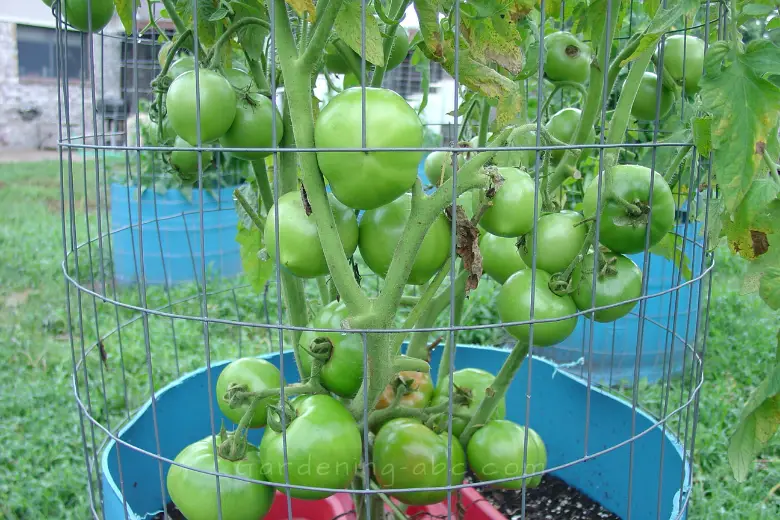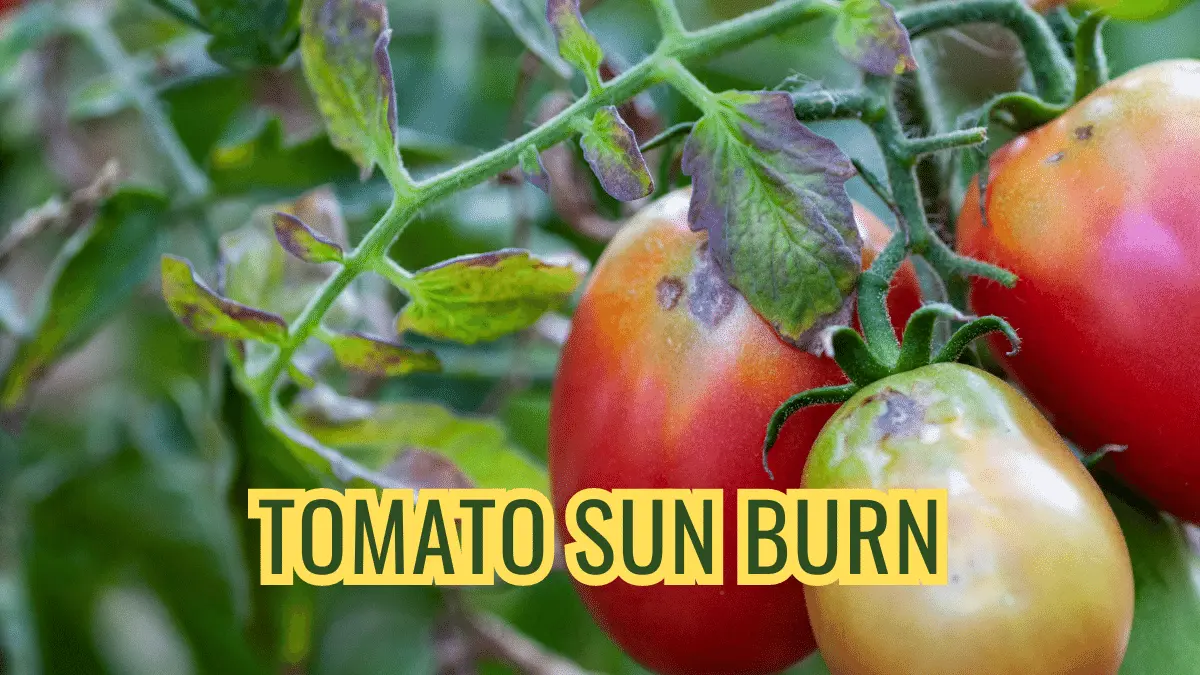We use affiliate links to run our site. When you buy through links on our site, we may earn an affiliate commission, without any added cost to you. Learn more
Sunburn on tomato plants can be frustrating for any gardener. One day your tomatoes are thriving in the summer sun, the next their leaves look dry, shriveled, and browned. Suddenly the fruit isn’t quite as plump and tasty either.
Although no plant is immune to the intensity of summer heat, there are several ways to prevent and treat sunscalded tomato plants. With a little planning and diligent care, you can still reap a bountiful harvest.
In this blog post, we’ll cover the common causes of sunburn, what sunburned leaves look like, and most importantly how to avoid sunscald on your precious tomato crop.
With a few preventative measures, you can still harvest platefuls of plump tomatoes this season. Get ready to outsmart the sun and win the battle against sunscalded tomato plants!
Common Cause Of Tomato Leaf Problems
Tomatoes need at least 6-8 hours of sunlight per day, but intense midday sun can easily burn their leaves and fruit. Sunburn most often occurs when the weather quickly changes from cloudy to hot and sunny. Plants have no chance to adjust their photosynthesis and transpiration processes.
Lack of wind circulation is another culprit. Plants surrounded by other vegetables or crowded cages don’t receive adequate airflow. Staking or trellising tomatoes opens their foliage to light breeze which helps regulate temperature.
Insufficient leaf covering around the tomatoes also leads to sunburn. Aggressive pruning of leaves exposes the delicate fruit to direct sun. While pruning helps prevent fungal diseases, it requires balance and strategy.
Tomato Fruit Problems Due to Hot Weather

Sunscald on tomatoes leads to aesthetic and flavor problems. A telltale sign is a distinct line between the burned yellow/white area and the healthy green flesh. Fruit may ripen unevenly and develop flat-tasting zones.
Tomatoes with blossom end rot also indicate too much sun intensity. This disorder causes brown sunken lesions on the bottom of the fruit. A dark leathery patch forms where the tomato rested on the soil.
Cherry tomatoes seem especially prone to sun damage. Their small size receives direct sun exposure, quickly escalating to scorched brown spots.
Sunburned Cherry Tomato Leaves
With cherry tomatoes, focus on prevention since their leaves and fruit are so delicate. Make sure these vulnerable plants receive filtered sunlight if possible. Dappled shade from larger vegetables like pole beans and corn helps protect them.
Choose heat-tolerant cherry tomato varieties like ‘Sun Gold’, ‘Sungold’, and ‘Sweet Treats’. Supplement water during dry spells so they are hydrated against sun and heat stress.
Can You Eat Sunburned Tomatoes?
Sunburned tomatoes are still safe to eat! Simply cut away the damaged parts. The flesh underneath is usually unaffected. Prioritize harvesting sunscalded fruit first before flavor suffers more.
How To Help Sunburned Plants And Prevent Sunburned Leaves
If your tomato plants already show signs of sunscald, don’t panic! Here are ways to nurse them back to health and prevent future damage:
With a few simple practices, you can avoid sunburn on tomato plants altogether:
Use a Shade Cloth and Keep Fruit Shaded
One of the most effective ways to prevent sunscald on tomatoes is to provide supplemental shade. Install shade cloths that filter 30-50% of sunlight over your tomato plants. These cloths diffuse the harshest midday rays but still allow sufficient light for growth.
For further protection, ensure the developing tomatoes themselves are shaded by foliage. Leave at least 5-6 layers of healthy leaves above each tomato, creating a natural umbrella against sun damage. Avoid aggressive pruning around the fruit. The leaves act like little shields, preventing direct sun exposure.
Prune Carefully and Don’t Over-prune
While pruning tomato suckers and older growth is beneficial, be careful not to over-prune foliage around the fruit. At most, selectively prune leaves immediately around each tomato to improve air circulation. Otherwise, leave as many healthy leaves intact as possible for shade coverage.
Only remove yellow or brown leaves that are 50% damaged or more. Make pruning cuts where the leaves join the main stem. Disinfect pruners between each cut with isopropyl alcohol to prevent transmitting diseases.
Avoid Overhead Irrigation
When watering tomato plants, avoid using overhead sprinklers or rainfall systems. Wet foliage is more prone to sunscald and diseases like blight.
Instead, irrigate at the base of plants using drip lines, soaker hoses, or directed sprays. Deep watering 1-2 times a week provides moisture for roots while keeping leaves dry.
Use Mulch

A 3-4 inch layer of organic mulch around tomato plants helps cool soil, reduces moisture evaporation, and prevents weeds. Shredded bark, wood chips, straw, or dried leaves are ideal mulch materials.
As they break down over the season, they also add beneficial nutrients to the soil. The cooler root zone created by mulch gives plants relief from hot sun exposure.
Actively Prevent Diseases
Tomato foliage provides critical protection against sunscald. Take steps to prevent leaf loss from common tomato diseases like blights and wilts.
Remove and destroy any diseased-looking leaves immediately. Treat plants with fungicidal sprays at the first sign of infection. Good airflow and crop rotation also limit disease outbreaks.
Grow Heat Tolerant and Disease Resistant Varieties
When selecting tomato varieties, look for types labeled as heat, sun, or disease resistant. Tomato cultivars like ‘Sun Leaper’, ‘Solar Flare’, and ‘Sun Master’ are bred to handle summer heat waves.
Disease-resistant hybrids will maintain their leaves better if you do get an outbreak. Matching variety to your climate helps avoid sun-related issues.
Harvest Early
As tomatoes start reddening, pick them promptly. Leaving ripe fruit on the vines in peak sun only escalates sunscald damage. Frequently harvesting encourages plants to keep producing more tomatoes as well.
Prioritize sunburned fruit – use or preserve it right away before the quality declines further. Staying on top of picking reduces risk.
Will tomato plants recover from sunscald?
With proper treatment, tomato plants can bounce back from the early stages of sunburn. Providing shade, ventilation, moisture, and removal of damaged tissue can all help sunscalded plants recover.
However, severely sunburned tomatoes may struggle to return to peak production. Focus on immediate prevention in future seasons.
How much water do tomatoes need?
Tomatoes require 1-2 inches of water per week from irrigation or rainfall consistently. During hot, dry spells increase watering to 2-3 times a week.
Use drip irrigation right at the root zone and avoid wetting foliage. A thick mulch helps retain soil moisture as well.
Final Thoughts
Preventing sunburn on tomato plants just takes a little foresight and TLC. Now you’re equipped with numerous techniques to avoid sunscald woes.
Try incorporating more shade, airflow, mulch, and heat-tolerant varieties this growing season. I hope these tips lead to your most successful tomato harvest yet!
Please share this post with fellow gardeners who may be fighting sunburned tomatoes as well. Explore the other articles on our site for more ways to get the most from your vegetable patch.
Most importantly, get out there and start implementing that shade cloth. Your tomatoes will thank you!
FAQS About Tomato Plants
Can tomato plants be cured of nutrient deficiencies?
Applying certain mineral supplements such as foliar spray or soil drench can often remedy nutrient deficiencies in tomatoes. Deficiencies appear as distinctive discoloration or distortions in leaves and new growth. Targeted fertilizers provide missing nutrients like nitrogen, potassium, phosphorus, or calcium.
What fertilizer is best for tomato plants?
Choose a well-balanced fertilizer with an NPK ratio around 5-10-10 or 10-10-10. Look for options labeled specifically for vegetables or tomatoes. Apply at transplanting and every 3-4 weeks thereafter. Fish emulsion, compost tea, and worm castings offer organic alternatives.
When is the best time to transplant tomato seedlings?
For most climates, tomato seedlings should be transplanted into the garden 4-6 weeks after germination when they reach 5-7 inches tall. Harden off plants for 7-10 days first. Time transplanting after the last expected frost when soil temperatures reach at least 55°F.
Should I cut dead leaves off my tomato plant?
It’s best to gently remove yellow or brown foliage from tomato plants if 50% or more of the leaf has died. Avoid cutting away green parts of leaves as it can stress the plant. Disinfect pruners between each cut to prevent the spreading of diseases.
Why are my tomato leaves turning white?
If tomato plant leaves are turning white or pale yellow between veins, it indicates the mineral calcium is deficient. Applying a calcium supplement as a foliar spray or soil drench can often restore healthy dark green foliage. Consistent watering, mulching, and pruning for airflow also prevent calcium deficiency.
Amazon and the Amazon logo are trademarks of Amazon.com, Inc, or its affiliates.

Hi there! My name is Prasenjit and I’m an avid gardener and someone who has grown a passion for growing plants. From my hands-on experience, I have learned what works and what doesn’t. Here I share everything I have learned.
